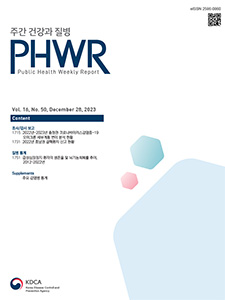Current Issue
Vol.16 No.50, December 28, 2023
-
Surveillance Reports 2023-12-28
 0
0
 227
227
 173
173
The Status of Genomic Surveillance of the Coronavirus Disease 2019 Omicron Subvariants in Chungcheong Region in 2022–2023
Jeemin Ha, Seon Do Hwang, Ye Na Yun, Sil Jung, Jun Ho Jeon, Jeong-Hoon Chun
Public Health Weekly Report 2023; 16(50): 1715-1730 https://doi.org/10.56786/PHWR.2023.16.50.1 Abstract
AbstractThe Chungcheong Regional Center for Disease Control and Prevention conducted variant analyses based on next-generation sequencing (NGS) for 3,595 confirmed cases of Coronavirus Disease 2019(COVID-19) in the Chungcheong region from February 2022 to June 2023. The variant viruses detected in confirmed cases in the Chungcheong region was all confirmed to be Omicron variants, and their specific sub-lineages were observed in the following order: BA.2 (38.1%), BA.5 (33.0%), XBB (27.3%), BA.1 (0.7%), other Omicron (0.5%), and BA.4 (0.4%). Analysis of the prevalence of COVID-19 variant viruses in different regions within the Chungcheong region showed that the sub-lineages were as follows: BA.2 (from February to June 2022), BA.5 (From July to December 2022), BN.1 (From January to March 2023), and XBB (from April to June 2023). These sub-lineages were consistently confirmed in the same order in all areas of the Chungchung region. Even in 2023, various Omicron sub-lineages continue to emerge worldwide, underscoring the growing importance of next-generation sequencing for analyzing the changing patterns of COVID-19 virus variants within the Chungcheong region and understanding the characteristics of domestic variant occurrences. The Chungcheong Regional Center for Disease Control and Prevention plans to continue monitering the COVID-19 variant viruses to prevent domestic introduction of new overseas variant viruses and to prevent their domestic spread.
-
Surveillance Reports 2023-12-28
 0
0
 204
204
 67
67
Characteristics of Notified Patients with Tuberculosis in the Honam Region, 2022
Aejung Lee, Jin Kim, Jieun Jung, Hayoung Park, Jeonghee Yu
Public Health Weekly Report 2023; 16(50): 1731-1750 https://doi.org/10.56786/PHWR.2023.16.50.2 Abstract
AbstractIn line with the national trend of decreasing new tuberculosis patients, the number of new tuberculosis patients in the Honam region (Gwangju, Jeonnam, Jeonbuk, and Jeju) is also decreasing every year, and the number of new tuberculosis patients in 2022 is 2,118 (37.2 per 100,000 population), an 11.0% decrease compared to 2021. Looking at the detailed status, the proportion of new tuberculosis patients aged 65 or older among new patients in the Honam region was 63.3% of all tuberculosis patients, which was higher than the national rate (55.8%). Additionally, the incidence of new patients was 113.2 per 100,000 population, which was 6.6 times higher than the incidence of patients under 65 years of age. Among new tuberculosis patients, only 9.9% are eligible for medical benefits. However, the incidence of new tuberculosis among those eligible for medical aid (89.6 per 100,000 population) was 2.7 times higher than that of health insurance subscribers (33.6 per 100,000 population). Additionally, there were 75 patients with multidrug-resistant/rifampicin-resistant tuberculosis, accounting for 2.8% of the total patients (2,686) in the Honam region. Although the total number of tuberculosis patients is continuously decreasing, the incidence of tuberculosis in the elderly over 65 years old and vulnerable groups is still high, showing the importance of systematic management of tuberculosis patients in vulnerable groups. The Honam Regional Centers for Disease Control and Prevention will continue to manage the national tuberculosis control project to eradicate tuberculosis so that it can be carried out without disruption.
-
QuickStats 2023-12-28
 0
0
 323
323
 146
146
Trends of Survival and Brain Function Recovery in Sudden Cardiac Arrest Patients, 2012–2022
Public Health Weekly Report 2023; 16(50): 1751-1752 https://doi.org/10.56786/PHWR.2023.16.50.3

pp. 1~2097
Most Keyword
?
What is Most Keyword?
- It is the most frequently used keyword in articles in this journal for the past two years.
Most Read
-
Waterborne and Foodborne Disease Outbreaks in the Republic of Korea, 2023
Myung-Jae Hwang, So Yeon Park, Hyungjun Kim, Se Jeong Yang, Sungchan Yang, Jin Seon Yang
Public Health Weekly Report 2025;18: 17-32 https://doi.org/10.56786/PHWR.2025.18.1.2 -
Implementation Plan for the Coronavirus Disease 2019 Vaccination for the 2024–2025 Season: Recommendations of the 6th Expert Committee on Immunization Practices
Hyewook Hwang, Wookeon Lee, Seohyeon Ahn, Young-Sook Choi, Seunghyun Lewis Kwon, Dongwoo Lee, Eun Hwa Choi, SokGoo Lee
Public Health Weekly Report 2025;18: 90-102 https://doi.org/10.56786/PHWR.2025.18.2.3
Editorial Office
+82-43-719-7569





 Full Text
Full Text Cite
Cite


